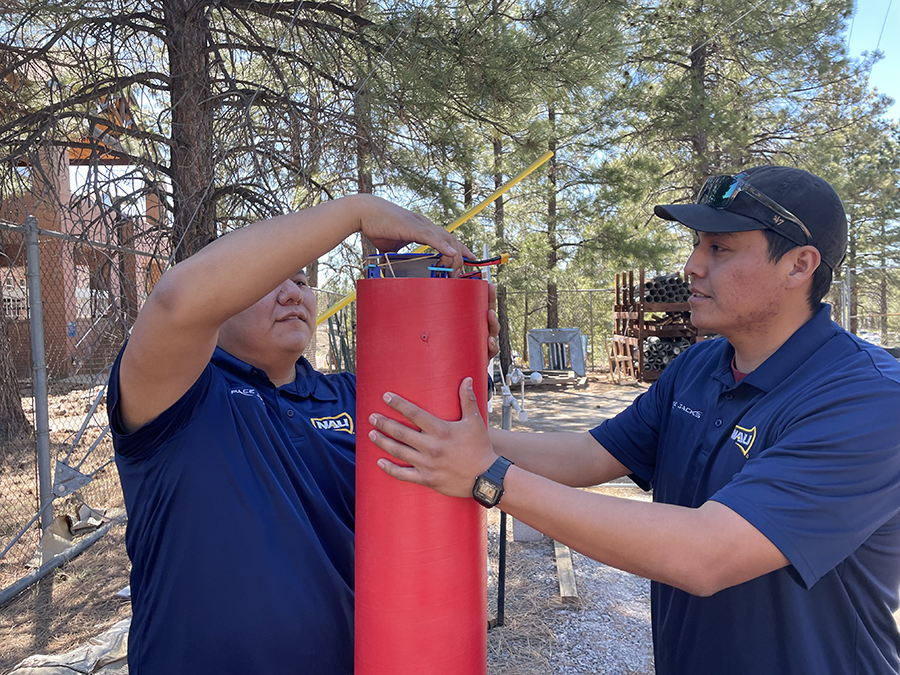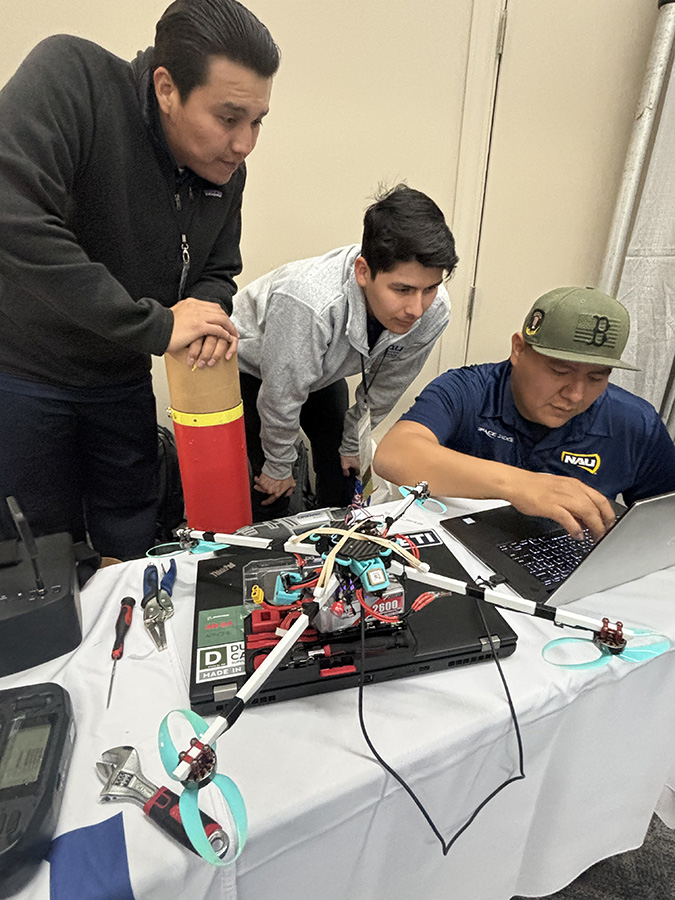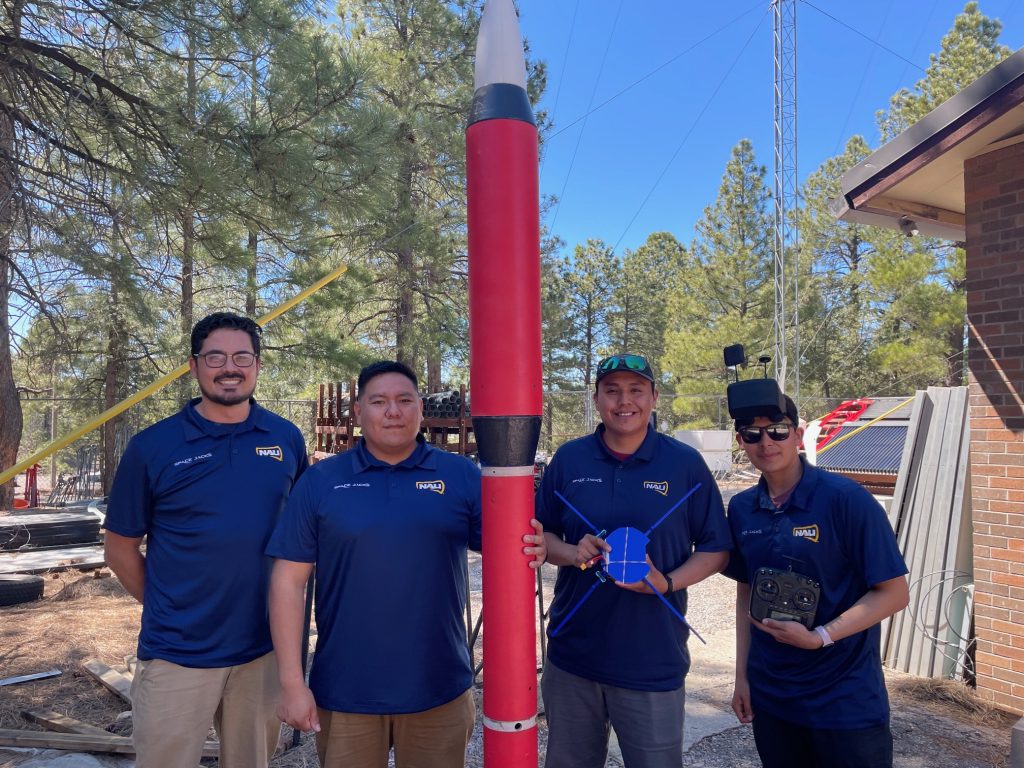Six months ago, Ryan Yazzie didn’t know anything about building a drone.
At the end of April, he piloted a drone that he helped design, which exploded out of a rocket that he helped build, and landed the drone, all pieces intact. The rocket parachuted to Earth, ready for another flight—once the team fished it out of the pond in which it landed.
It’s all part of a day’s work for the members of Space Jacks, NAU’s rocket club, which at the end of April competed at the First Nations Launch high-power rocket competition at Carthage College in Kenosha, Wisconsin. First Nations Launch is part of NASA’s Wisconsin Space Grant Consortium and is a competition for students attending a tribal college or university, Native American-Serving Nontribal Institutions or who are active members of an American Indian Science and Engineering Society (AISES) branch.
“The team worked tirelessly through the days leading up to our travel to Wisconsin, and all of our hard work and dedication paid off when we finally arrived and presented our project to the judges,” said Joshua Wilson, the team lead and a senior mechanical engineering (ME) major. “The judges were present at every milestone presentation, and over the past four months they witnessed our competition rocket and drone evolve from a CAD design to a fully working product.”

Wilson, Stonn Billy and Yazzie, both junior ME majors, represented NAU in Wisconsin, with faculty advisor Carson Pete, an assistant teaching professor in the Department of Mechanical Engineering and faculty advisor for Space Jacks. Kayden Vicenti, a junior studying computer science and electrical engineering, and Gabrielle Hall, a senior studying electrical engineering, also are on the team but did not make the trip.
Wilson said the judges, which included representatives from NASA, Blue Origin, Raytheon, General Electric and other companies, were impressed with what NAU’s team accomplished. They’ll find out this summer if they won any awards.
“Our team did well this weekend—we got our drone issues worked out and the rocket flew well,” Pete said. “It did land in a lake, but we were still able to recover it!”
It IS rocket science

The competition, now in its 15th year, changes every time. This year, students had to build a rocket that went 2,500 feet up and that deployed a drone that could then be piloted to the ground by a certified drone operator. The drone had to be retractable and fit inside the rocket. The rocket also had to land in good enough condition that it could fly again.
The Space Jacks team is made up of engineers, but there’s not exactly a rocket-building class for them to take. Wilson and Billy were on the team last year—Billy was the team lead then—but because it was a different competition, they couldn’t just reuse the old rocket. So they studied how to build rockets. They studied how to design a drone. They studied the different materials needed to build a strong but light rocket, how much durability and flexibility they could get from 3D-printed materials for the drone and how to fit the separate pieces of the rocket together. They made models of each of the separate pieces and ran hundreds of simulations.
NAU’s team had an industry partner, Flagstaff aerospace company Novakinetics, which donated materials and allowed the Space Jacks to use their facilities, as well as an industry advisor, Intel engineer Kevin Small.
There was also a lot of trial and error. It’s the nature of the work.
“It’s hard to get experience in aerospace without getting your hands dirty,” Pete said.
And if you’re going to get your hands dirty, why not launch a rocket at the end of it?

The competition happens in phases—the team submitted reports and designs along the way laying out how they planned to build and launch their rocket, how they would determine its flight readiness and more. Now that the rocket has launched, they’re awaiting a post-launch assessment review.
Why they do it
It’s fun—sometimes.
“It’s been a challenge,” Wilson allowed after a lengthy pause following an observation from someone who’s never built a rocket that it looks like fun.
Whether the task is more on the fun or frustrating end of the spectrum, it’s the kind of
experience that mechanical and electrical engineers and computer scientists want as they’re applying for internships and jobs. And that experience has paid off; last summer, Billy interned at Boeing and Wilson interned at Northrop Grumman. Pete said members of Space Jacks have interned at virtually every American aerospace company in the decade since First Nations Launch started.
They also get to see how other teams have done the same task. The rocket fair on launch day eve is the chance for all the students to walk around, see other rockets, ask questions and swap stories. The Wisconsin Space Grant Consortium also invites industry professionals who are Indigenous to share their stories with the students. Capt. Haida StarEagle, a 17-year veteran of the Air Force and the first Native American to join the U.S. Space Force, has spoken at past competitions, and John Herrington, one of the first Native American astronauts, spoke this year.

Lumberjack pride was also on the line. Two years ago, NAU came in first. Last year, they won bronze—beaten out of the top spot by MIT and University of Washington.
“I wasn’t happy with third place,” Wilson said.
Supporting students
To build a rocket and a drone and travel to the competition, Space Jacks got a grant from the Wisconsin Space Grant Consortium to fund materials and travel. Additionally, the NASA NAU Space Grant and Office of Undergraduate Research provided grants to help the team complete the work and travel to Wisconsin.
Wilson, Yazzie and Billy are returning next year, though Wilson is handing over the team lead torch. He shared some advice as he reflected on what he’s taken away from his time with Space Jacks.
“Communication and dedication are going to be critical components to the team as a whole and will only grow stronger as the project progresses,” he said. “The team lead for any project would do well to establish a sense of camaraderie between all teammates, so everyone feels connected to the project and each other. The skills that you learn here in the academic setting transfer over to any career field, and in my mind, having someone with those traits is a fundamental asset to any employer.”
If all goes well, the Space Jacks’ next rocket will be at the Tripoli Phoenix site in October.
Heidi Toth | NAU Communications
(928) 523-8737 | heidi.toth@nau.edu




